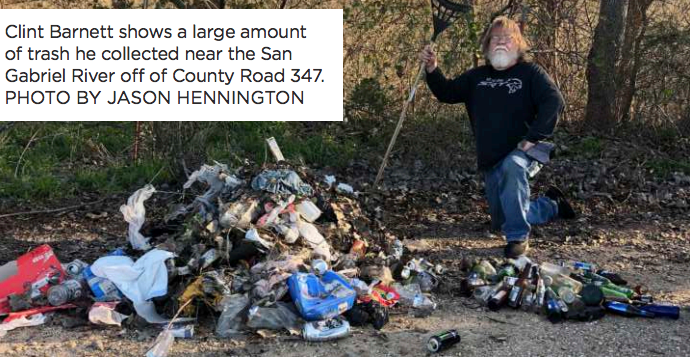RIVER OF REFUSE San Gabriel River sees a plague of dumping
GRANGER — What was once a serene landscape along the San Gabriel River near CR 347 has become a scene of distress, marred by heaps of trash both on land and in the water. This pollution has sparked a local resident’s determined campaign to clean up the area, a crusade he has recently documented on social media.
In response to a video exposing the pollution, the area was temporarily shut down to allow for enhanced cleanup operations by the Army Corps of Engineers, the Texas Parks and Wildlife Department and the Precinct 4 Constable’s Office.
Despite these concerted efforts to address the environmental damage, the problem persists, leading law enforcement to explore advanced technologies to better manage and mitigate the ecological threat.
COMMUNITYOUTCRY ANDCLEANUP
Clint Barnett, a 20-year resident of this stretch of the San Gabriel, has dedicated the last 15 years to cleaning up the waterway. One of his Facebook videos vividly documents the extent of the problem, showcasing an uninterrupted line of garbage along the road and illustrating his deep frustration.
“Do the people who live here really want to see this mess? We don’t want to. You should be ashamed of yourselves,” he said.
Barnett’s footage shows an abandoned TV in the brush, scattered beer cans, water bottles, countless wrappers and a floating island of refuse drifting in the river.
“All this garbage and dirty diapers will eventually end up in Taylor’s drinking water, and you can’t filter it all out,” Barnett said.
According to Barnett, he has been engaged in a prolonged struggle with the Army Corps of Engineers, which owns the land, and Texas Parks and Wildlife, which leases it, to keep the area picked up.
He added he has pleaded with both agencies for years to address the issue.
OFFICIAL RESPONSE
In response to Barnett’s videos, the corps and TPWD issued a joint statement July 3 outlining their position: “The U.S. Army Corps of Engineers owns and manages the property where the dumping occurred. Texas Parks and Wildlife Department leases property from USACE for public hunt lands. Williamson County game wardens are collaborating with USACE and the Williamson County constables to develop a plan for monitoring the area and will take action against violators once identified.”
The statement continues, “Given the extensive illegal dumping, USACE has closed public access points until the situation can be reassessed. Additionally, the local TPWD biologist is working with community partners to organize cleanup efforts. USACE and TPWD urge visitors to take their trash with them, as there are no serviced trash receptacles on-site. Leave no trace.”
CHALLENGESINENFORCEMENT
When the land was closed to the public, Precinct 4 Constable Paul Leal surveyed the area.
“This is terrible, it’s really terrible,” Leal said, observing an overflowing trash can Barnett had placed there out of exasperation.
“Now, I can’t address this garbage because it’s next to a trash can,” Leal said. “I can only assume that people thought someone would empty it. This is different from those who simply leave their trash by the water.”
Barnett removed the receptacle to prevent any misunderstanding.
Aerial surveillance and cameras could be the keys to prevention, the constable said.
“I believe that if we fly a drone a half a mile that way and a half a mile the other way, we’ll find a good starting point and place our cameras in-between,” Leal said. “They’ll be eyes for us, when we’re not there.”
With only four deputy constables assigned to environmental duties across the 620-square-mile Precinct 4, catching litterers in less frequented areas can be challenging, he said.
In 2020, Precinct 4 launched the “You Dump It, You Clean It” initiative, which allows individuals cited for littering to reduce the charge to a Class C misdemeanor if they clean up their mess, take the debris to the Williamson County landfill and provide a receipt.
According to Leal, this initiative saved taxpayers half-a-million dollars and reduced roadside debris by 426 tons in two years. Leal hopes to replicate this success along the San Gabriel with the help of surveillance cameras.
CURRENTANDFUTUREEFFORTS
After two weeks, the area reopened. A recent visit revealed signs of cleanup efforts, such as a large black garbage bag resting against a tree. However, some refuse, including a Styrofoam container, still littered the area. Leal noted that Styrofoam is particularly problematic as it doesn’t break down easily and can harm wildlife.
Deputy Constable R. Johnson, one of the Precinct 4 officers responsible for environmental enforcement, noted garbage is also harmful to people. The trash eventually makes its way to Granger Lake where Taylor residents source their drinking water.
“Pick up your garbage. It takes just two seconds; you are ruining beautiful land by leaving it,” Johnson said.
COMBATINGILLEGALDUMPING
Residents or visitors can report illegal dumping to the Williamson County Environmental Services, the Williamson County Sheriff’s Office, and the Constable’s Office. If you are interested in getting involved in litter prevention, the Texas Department of Transportation’s Adopta- Highway Program allows groups or individuals to adopt a section of roadway and commit to regular litter pickup.
The Williamson County Conservation Foundation often organizes or supports local cleanup events and educational programs related to environmental conservation.
To view some of Barnett’s videos, go to eastwilcoinsider.com.








Comment
Comments